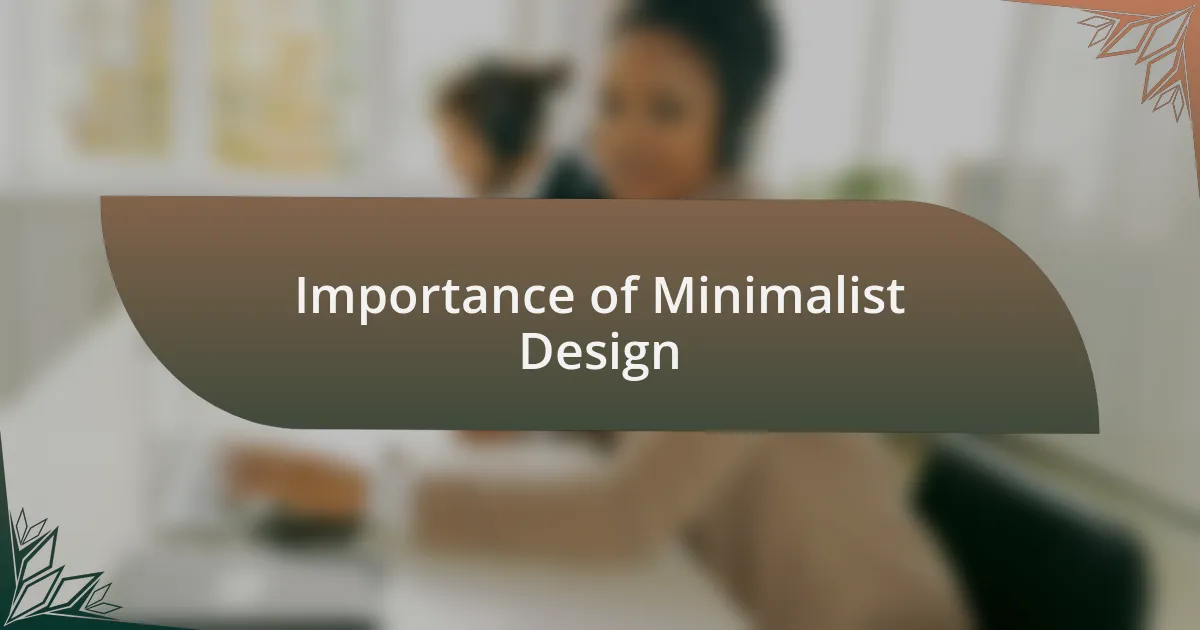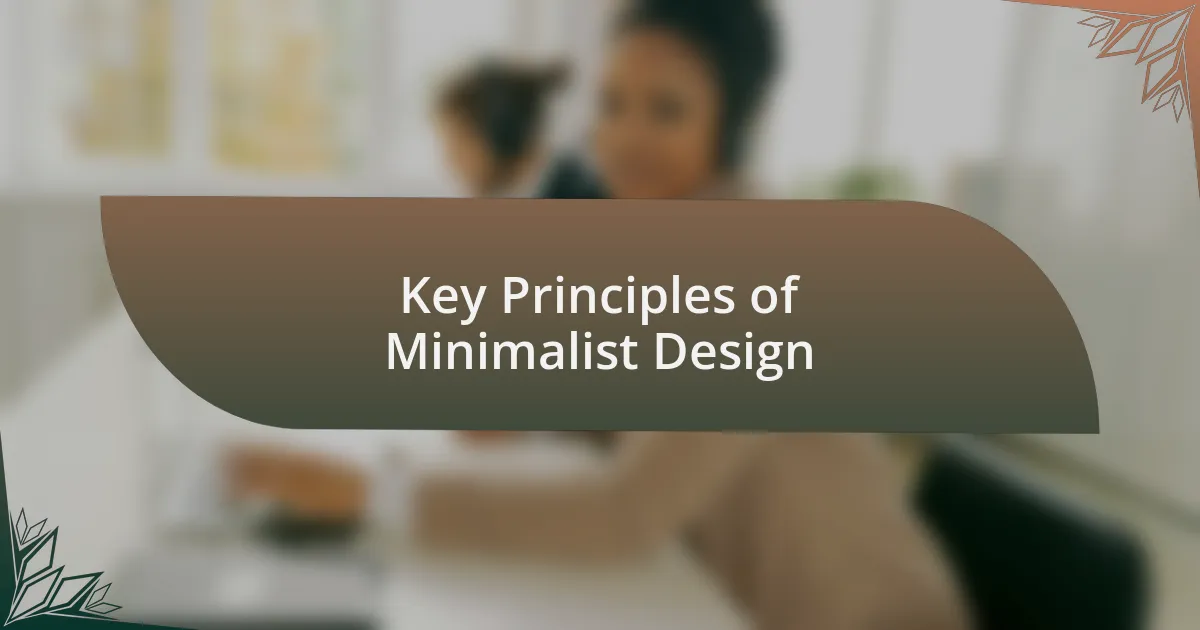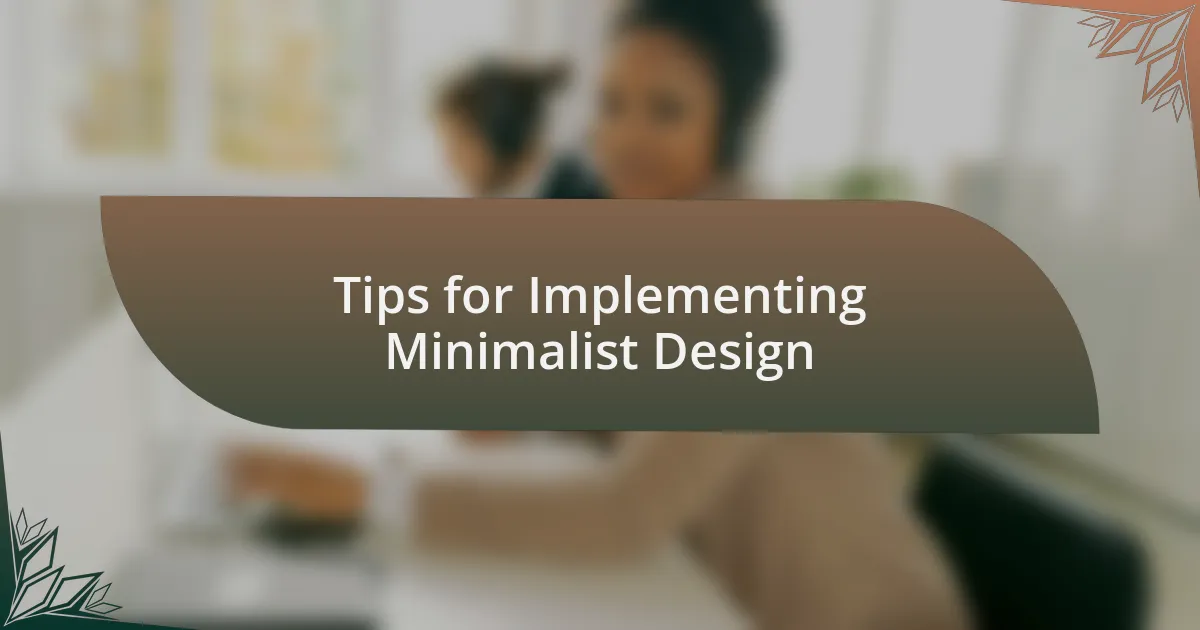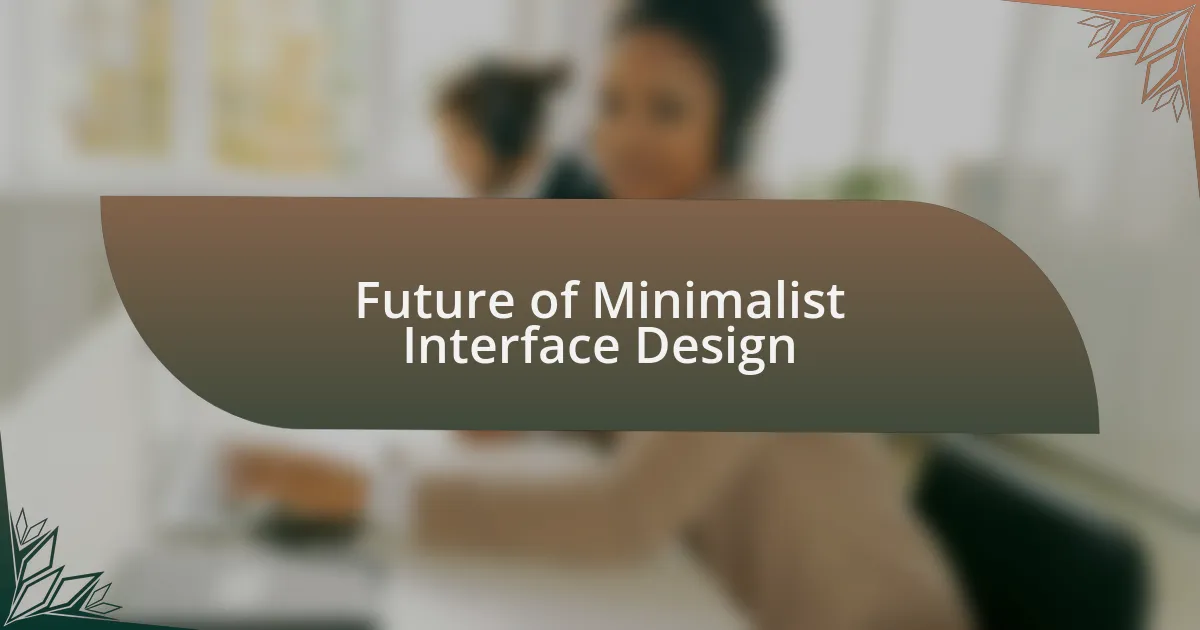Key takeaways:
- A minimalist interface prioritizes simplicity, enhancing user focus by removing unnecessary elements and distractions.
- Key principles include “less is more,” effective use of white space, and maintaining a consistent visual language for better user experience and brand identity.
- Implementing minimalist design reduces cognitive load, improves loading times, and fosters a stronger emotional connection with users.
- The future of minimalist design may incorporate AI for adaptive layouts, sustainability practices, and the integration of voice user interfaces (VUIs).

Definition of Minimalist Interface
A minimalist interface is designed with the principle of simplicity at its core, focusing on essential elements while eliminating unnecessary clutter. It’s about creating a clean space that allows users to navigate effortlessly, making everything feel intuitive. When I first encountered a minimal design, I was struck by how much easier it was to concentrate on my tasks—there were no distractions vying for my attention.
Think about it: when was the last time you felt overwhelmed by too many buttons or colors on a webpage? I remember visiting a site filled with graphics and features, which left me frustrated and lost. In contrast, a minimalist interface calmly guides users toward their goals, fostering a sense of peace and clarity through careful design choices. It’s as if the site is holding your hand, reassuring you that everything you need is right there, and nothing more.
The essence of minimalist design lies not just in fewer elements, but in the thoughtful placement and purpose of each element. Each button, each space, and each line is deliberate, crafted to enhance user experience. This makes me reflect on the first time I redesigned my own portfolio website; stripping back to what truly mattered made my work shine brighter than ever. It became clear to me that sometimes less really is more.

Importance of Minimalist Design
Minimalist design is essential because it fosters an environment where users can focus. When I switched to a clean, uncluttered layout for my freelance website, I noticed an immediate difference in visitor engagement. Users commented on how refreshing it was not to be bombarded by flashy visuals; instead, they could easily find the information they needed without distraction.
Moreover, a minimalist approach often enhances accessibility. Consider how overwhelming excessive design can be for someone with visual impairments. I remember redesigning a friend’s e-commerce site with a focus on simplicity and readability. We reduced the color palette and streamlined navigation, making it more user-friendly across different devices. The feedback was overwhelmingly positive, as it not only improved the user experience but also boosted sales.
The emotional impact of a minimalist design should not be underestimated. Have you ever felt a sense of calm just by being in a well-designed, airy space? I believe that a website can evoke similar feelings. By stripping away the non-essential, we create a space that invites users to breathe and think. It transforms the browsing experience into something genuinely pleasurable, encouraging users to stay longer and explore. Every click feels deliberate, making the interaction feel more meaningful.

Key Principles of Minimalist Design
Key Principles of Minimalist Design
One of the core principles of minimalist design is the idea of “less is more.” When I first embraced this concept, I began stripping away unnecessary elements from my workflow and noticed how much more clarity I gained. It taught me that simplicity doesn’t mean sacrificing quality; rather, it elevates the essential components, allowing them to shine. Have you ever felt overwhelmed by too many choices? Minimalism helps to narrow focus, guiding users effortlessly toward the most important actions on a site.
White space plays a crucial role as well. Initially, I hesitated to leave large areas of empty space on my designs, thinking it looked “unfinished.” However, I soon discovered that these spaces breathe life into the content, letting it stand out without distractions. It’s like walking into a room filled with natural light; the atmosphere instantly feels more open and inviting. This principle not only enhances the visual appeal but also contributes to a more pleasant navigation experience.
Finally, a consistent visual language unifies the elements of a minimalist design. When I revamped my portfolio, I chose a cohesive color scheme and typeface to promote a seamless experience. This intentionality resonates with users, reinforcing brand recognition and trust. Isn’t it fascinating how something as simple as consistent styling can create a strong connection with your audience? It fosters familiarity and comfort, encouraging visitors to explore without hesitance.

Benefits of Minimalist Interfaces
Minimalist interfaces significantly reduce cognitive load for users. I remember redesigning a client’s website that was cluttered with information and flashy graphics. After adopting a minimalist approach, the client noted that users seemed to spend more time on the site, engaging more thoroughly with the key content. It was as if the weight had been lifted, allowing the message to resonate. How much easier is it for you to make decisions when distractions are minimized?
Another undeniable benefit lies in improved loading times. When I streamlined my own site by trimming unnecessary elements, I was pleasantly surprised to find that page loading speeds increased dramatically. Not only did this enhance the user experience, but it also positively impacted search engine optimization, drawing more visitors. Have you ever abandoned a website because it took too long to load?
Finally, minimalist design promotes a stronger brand identity. During a recent project, I focused solely on essential elements that communicated the brand’s values clearly. This clarity in design not only enhanced user trust but also created a lasting impression. It’s amazing how establishing a direct visual message can keep the brand at the forefront of users’ minds, isn’t it? Each element becomes a powerful ambassador of the brand instead of mere decoration.

My Experiences with Minimalist Design
Implementing minimalist design has been a transformative experience for me. I vividly recall tackling a project where the initial interface was an overwhelming mix of colors and fonts. Once I stripped it down to essential components, it felt like a breath of fresh air—not just for myself but for the users as well. I found that their focus shifted from navigating chaos to appreciating the content, which evokes a deep sense of satisfaction. Have you ever felt the relief that comes with simplicity?
In another instance, I decided to redesign my personal portfolio with a minimalist mantra. I chose a limited color palette and streamlined my typography, and the result was stunning—an unexpected clarity in showcasing my work. It created a space that allowed the pieces to shine, almost as if they were speaking for themselves. I often think about how captivating designs can be when they stand back and let the content take center stage, don’t you agree?
Lastly, I’ve observed that minimalism often aligns perfectly with user expectations. During usability testing, I noticed that users directly connected with a clean layout more than any complex design I had presented. Their feedback was overwhelmingly positive, emphasizing their preference for straightforward navigation. It made me realize how a well-executed minimalist design doesn’t just foster ease of use; it cultivates an emotional connection with the audience. Isn’t it amazing how much can be communicated with so little?

Tips for Implementing Minimalist Design
When implementing minimalist design, one of the most valuable tips I’ve learned is to focus on functionality. In my own projects, I often start by asking, “What does this element contribute to the user experience?” If it doesn’t serve a clear purpose, I remove it. This practice has taught me that each design choice should enhance usability, making the interface not just stylish, but also genuinely helpful.
Another approach I find particularly effective is embracing whitespace. I’ve experimented with various layouts, and I’ve noticed how giving elements room to breathe makes a significant difference. I recall a project where I increased the spacing between text blocks, and it instantly lifted the overall aesthetic. It’s fascinating how a bit of space can create a sense of calm, allowing users to focus on each piece of content without feeling overwhelmed. Have you noticed the impact of whitespace on your own designs?
Lastly, consistent typography can elevate a minimalist design. I once worked on a website where I chose just two typefaces for the entire project. This simplicity not only unified the design but also made the text more readable. I believe that when you limit your type choices, you create a stronger visual hierarchy, guiding users effortlessly through your content. Isn’t it intriguing how a few carefully chosen fonts can transform an entire layout?

Future of Minimalist Interface Design
As I look ahead, I genuinely believe that the future of minimalist interface design lies in the integration of advanced technologies, particularly artificial intelligence. In my own experiences, I’ve seen how AI can analyze user behavior and preferences to offer designs that adapt in real time. Imagine a website that changes its layout based on how you navigate through it; I think that would elevate the user experience to a whole new level. Isn’t it intriguing to think about how responsive design could become?
Moreover, I sense that sustainability will increasingly influence minimalist design choices. As designers, we have an opportunity to advocate for eco-friendly practices, such as choosing a limited color palette that not only simplifies aesthetics but also reduces resource consumption in production. In one project, I chose a color scheme that minimized printing needs, and it felt rewarding to contribute to a more sustainable approach. How can we, as creatives, further embrace this responsibility in our designs?
Lastly, I anticipate that the rise of voice user interfaces (VUIs) will reshape how we approach minimalist design. With voice-activated technology becoming more prevalent, I can envision a future where designers prioritize auditory experiences alongside visual elements. I remember a client who was curious about incorporating voice commands into their e-commerce platform. It made me rethink the traditional interactions we design around clicks and taps, underscoring the need for versatility in minimalism. How do you think VUIs might challenge our current design paradigms?